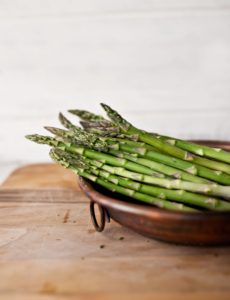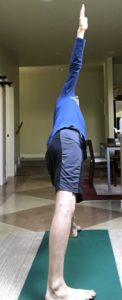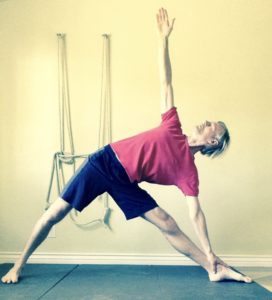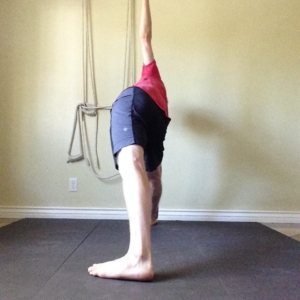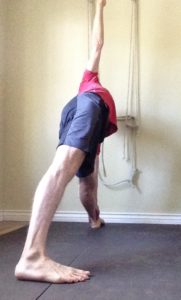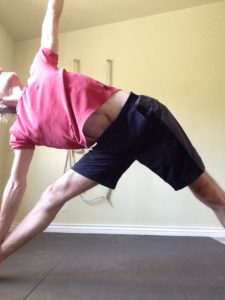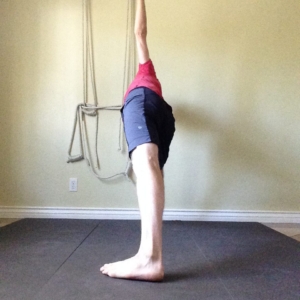Flexibility vs. Mobility of the Hips
in Health Article, Movement Article, Personal Alignment Training, YogaThe first yoga class I ever took was a Bikram Yoga class at The Yoga College of India in North Beach San Francisco. It was a 6 pm class held in a heated room that followed a 4:30 class full of tired, sweaty bodies. The room was ridiculously hot and wet even before I’d even taken my first pose, and I’m certain that I have never struggled and sweat that much before or since.
Besides a sore back and a wounded ego, I came away from that class with the discovery that I was, in fact, pretty flexible. I had no idea I was capable of bending my body in the ways I did in my early days of taking yoga classes. Years later a client came to me who’d been taking Bikram Yoga classes and was recently diagnosed with a disc herniation. She told me that what she really enjoyed most about her experience in Bikram classes was the “noodly bendy” feeling. Her body was already very flexible and therefore being even more “bendy” was the last thing she needed, but I understood where she was coming from. Flexibility is desirable not just because it can be an indicator of good health, but also because it just plain feels good.
After suffering for several years with my own back issues I’ve come to see flexibility in a different way. It’s clear to me now that for myself and the many others who have or have had chronic pain, flexibility is part of the problem. At least the “bendy” kind of flexibility that lacks a stable foundation. People with bendy bodies are often drawn to yoga classes, especially Bikram or other “Hot” yoga classes because bendiness comes easy to them. It can be very challenging for these very “flexible” students to improve their stability doing yoga, and they often manifest injuries that begin to limit their mobility, sometimes dramatically so.
When my “noodly” client first came to me she could barley bend forward, despite her natural flexibility. As I helped her improve her mechanics she gradually became more stable and her mobility improved dramatically without the back pain returning.
When I work with a client who lacks flexibility, I try to help them find ways to improve their mobility rather than just giving them stretches to make them more flexible. It can feel good to be “flexible,” but ultimately it is the quality of our movement that counts. And that quality of movement depends a great deal on stabilization.
Stabilization means that I am able to maintain stability in one part of my body while I move another. If for example I am bending forward, I want to stabilize my spine so that I can generate more of the movement from my legs and hips. Stabilizing the spine is essential for increasing range of motion in the hips. Stabilizing the hips is essential for the long term health and function of these very important joints.
Stabilizing my hip joint requires that I stabilize the femur (thigh bone). This demands a good balance between the strength and responsiveness of my lateral hips and the flexibility and freedom of movement from my medial hip. If the muscles on my lateral hip don’t respond well to loads (ie-lack strength), the medial hip muscles will shorten and pull one femur toward the other. This can compromise the stability of the hip joint and will eventually damage it.
Conversely if I do have good balance between my later and medial hip then I am able to stabilize the femur effectively and this will allow for better mobility of my hip. Better hip mobility improves the health of the hip joint and greater stability through a larger range of motion.
I’ve found stabilizing the hip to be a very effective way to improve hip mobility and resolve hip related pain patterns. In my view mobility is the kind of flexibility we want. That is, not the “noodly bendy” kind but the kind that makes us stronger and affords us more range of motion and freer movement while minimizing wear and tear on our joints.
For a demonstration of one of my favorite posture for improving hip stabilization and mobility, check out this video.
High Lunge for Hip Stabilization and Mobilization
in Balance, Movement Article, Personal Alignment Training, Videos, YogaI’ve been really loving the short movement sequence shown in this video. It’s got a number of applications including stabilizing the hip joint, increasing range of motion in the hip, trunk stabilization and training for better throwing mechanics. I also find this sequence an ideal preparatory movement for classical standing asana in that it helps to awaken the movement patterns that really bring yogasana to life. Check it out!
Why Do A Spring Cleanse?
in Ayurveda, Health Article, YogaNow that I’m wrapping up with several clients whom I’ve guided through our Spring Cleanse and Ayurvedic De-tox, and now that Tiffany and I have finished our own annual spring cleanse, I have a few thoughts that I’d like to share with you. First, I recognize that a lot of you are interested in the cleanse but you’re not sure if the program we offer is one that will fit your timeframe, commitments and/or lifestyle. Let me provide a few more details on our program so that you have a better idea of what you’d be getting into if you, should you decide to try it.
Our program generally takes about 2 weeks to complete, give or take a few days. For daily coffee drinkers I generally recommend tapering off in advance of starting the first week of the cleanse. If you count these days you’re reducing your coffee intake, then it can add a little extra time to the program. I also think it’s a good idea for people who drink alcohol regularly to stop for 2 or 3 days before beginning to make other changes to diet and lifestyle. It’s not essential, but even moderate drinkers can sometimes experience a bit of withdrawal from stopping all intake of alcohol and it’s good to get this out of the way before starting this process.
Ayurvedic cleansing is partly about taking as much pressure off the digestive system as possible so that it can do it’s job more efficiently. That job, to transform the food we eat into a form that we can easily assimilate and transform into healthy tissue, can be made more difficult in multiple ways. Eating too fast, eating inappropriate food, eating at the wrong time and eating under stress are just a few of many examples of behaviors that make it harder for our digestive system to transform our food in an optimal way.
Some of these examples, such as eating under stress, may be due to circumstances beyond our control. But others, such as our choice of food, are well within our control and provide opportunities to make choices that are more favorable to our digestive health, better for assimilation, and helpful for producing better quality tissue along with better health overall.
When we make good choices with diet and lifestyle, good digestion and good health tend to follow. But we don’t always make the best choices and our digestion may suffer as a result. When this happens we tend to have poor transformation of food, poor assimilation and may sometimes begin to accumulate toxicity in the digestive tract.
Let me pause here a moment as say that while the above scenario is far from optimal, it is typical for most of us. Life gets in the way of making good choices and as I said, sometimes things are beyond our control. So this formation and accumulation of toxicity in the G.I. tract is something we all tend to have to some extent or another. And when this toxicity sticks around long enough it will eventually be absorbed and follow the food path into our tissue where it can damage tissue health and cause disease.
Again, this accumulation of toxicity is going on to some extent in all of us. However, a proper cleanse is a way of clawing back some of the health we lose as a result of these accumulated toxins, and while I can only offer anecdotal evidence that it works, my experience and that of the clients I’ve guided through the cleanse is a sense of renewal and clarity. The body and mind feel cleaner, better lubricated and they begin to hum along like a well tuned machine (I’m not generally crazy about the machine analogy when discussing the human body but I’m hoping it speaks to you in this case).
In addition to eliminating various foods and beverages to take stress of the digestive system, our spring cleanse also helps eliminate the toxicity that has already made its way into the tissue. This is what makes it different from other popular cleanses or fasts. Our program goes this extra step and and I think that’s what makes it so effective.
Tiffany, myself and our clients have experienced quite a few specific positive changes as a result of doing the spring cleanse. One is less pain in our bodies. Last year a client who has some arthritic joints saw a dramatic reduction in arthritic pain. This year some minor hip/back pain I’d been having resolved during the cleanse. For some clients, minor aches and pains completely disappear.
Another positive change that we’ve noticed in ourselves and in our clients is an improvement in mental clarity. Nearly every person that we’ve guided through the spring cleanse has commented on feeling more clear mentally during and after the cleanse.
The cleanse has also proved helpful to clients with long standing digestive issues, and some of them have seen those issues significantly reduced or even eliminated during the cleanse. These are folks who have already tried making substantial changes to their diet in the past, such as eating a gluten free diet or eliminating dairy, without really seeing a signifiant change in their symptoms.
The dietary changes in our spring cleanse starts with an elimination of alcohol and caffeine and a short list of hard to digest foods. These changes can have a big impact on how we feel physically, but can sometimes be difficult psychologically (I know they sometimes are for me). I try to remind myself and my clients that however difficult some of these changes might be, they are only temporary and we needn’t feel that we must take on a major overhaul of our diet and lifestyle going forward – FOR THE REST OF OUR LIVES! This is not the point of the cleanse anyway. This cleanse is about making short term changes that have specific intentions meant to have specific effects, and once those effects are achieved then we should feel very free to go back to our normal diet.
Still, longer term changes can and do happen and most clients will decide to continue with some of the changes they’ve made during the cleanse even after they finish. Last spring, for instance, one client decided not to go back to caffeine after her cleanse. She decided she didn’t need it and gave it up. I’m not sure I could ever do that but I fully support her choice and was impressed with her resolve.
I’d also like to emphasize that our spring cleanse is not about pain and suffering. You will be eating three squares a day and will be encouraged to avoid anything that creates a lot of stress for you. In the same way that the cleanse design is partly about taking stress off of your digestive system, it’s even more about taking stress off of you. This give you space to see yourself more objectively and gain some clarity – about your diet, your lifestyle, your body, your mind and your health in general. This space allows the foods, substances or behaviors that aren’t serving you to be brought into focus and it begins a process of letting some things go. Ideally this happens gradually, naturally, and without difficulty.
Still, for those of you who aren’t up for any or all of the above, there are some good ways of making smaller changes this spring that will still have a significant impact. Here are a few:
- Take a break from alcohol : If you drink alcohol regularly, it’s a good idea to take a break now and again. Try taking 2-4 weeks off entirely and see how you feel. Remember. It’s only temporary!
- Lighten your diet : The qualities of moist and heavy tend to accumulate over the winter in the form of excess kapha. Look at all of the light green vegetables nature offers us this time of year. Asparagus, sugar snap peas and spring onions help reduce excess kapha and improve digestive health. Don’t like those foods? Just try eating less cheese.
- Reduce Raw and Favor Cooked : Fresh raw veggies are so healthy right? Well yes, but they contain little or no fire element and can be too cooling for some and place a drag on our digestive fire. The solution – cook your veggies well. Worried about losing their valuable nutrients? Consider all of the nutrients you’ll be getting from your food when your digestion is really working its best!
- Stop Snacking: Small meals more often is in my view, unhelpful for most people. Our digestive system needs time to complete the process of digestion and having a new meal after 2 hours, however modest, doesn’t allow that process to reach completion.
- Try Intermittent Fasting: This can be as simple as not eating after a certain time or leaving at least 12 hours between your evening meal and your breakfast. Feeling more ambitious? Try skipping dinner one day a week.
There’s still time to schedule your Spring Cleanse and Ayurvedic De-Tox. If you’re interested or have more questions, feel free to email me any time.
Happy Spring!
Guided Relaxation (Shavasana)
in Cardiovascular Health, Health Article, YogaThis is a long time coming. I’ve had students asking me for a recording of my guided shavasana for at least a decade. For those of you who’ve been asking for it, I hope it was worth the wait.
For those of you who are non-yogi’s, this recording is basically a guided relaxation. Before starting the audio, lie in an appropriate position. If you’re not sure which position to lie in, I can recommend Psoas Release on a Bolster. You can watch a video demonstration of this posture here.
As this is my first try on recording a guided relaxation, I am aware that there is plenty of room for improvement. I welcome your feedback!
Namaste’
A Short Progression for doing Plank Posture
in Movement Article, Personal Alignment Training, Videos, YogaA common mistake made doing plank pose is using the hip flexors to support the weight of pelvis. This is shown in the photo below.
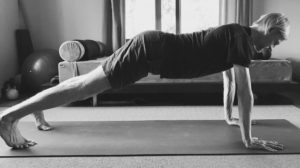
If the hip flexors are active, they tend to tilt the pelvis forward (anteriorly), relative to the rib cage. This results in a mis-alignment between the pelvis and the rib cage and inhibits the deep abdominal and pelvic floor muscles, severely compromising pelvic and trunk stability and placing much more of the load on the shoulder girdle and lower back.
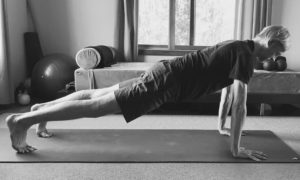
When the hip flexors are relaxed, it allows the pelvis to align with the rib cage in a way that allows the deep abdominal and pelvic floor muscles to respond to the weight of the pelvis and lower trunk. With the help of the quadriceps and toes, the total weight of the body is then distributed evenly between the feet, legs, pelvis, trunk and shoulder girdle.
Thoughts on Communication and the Breath
in Health Article, Movement Article, YogaIn an earlier post I offered some thoughts on communication, specifically communication between ourselves and our bodies. That post emphasized how our muscles respond differently depending on what we’re telling them, and it highlighted the fact that we can solicit the response we want, muscularly, when we’re clear about our intentions and effective in communicating our message.
Now this topic is coming up again and I find myself talking about it frequently with my students. The difference is that I’m talking more about the ways our bodies seek to communicate with us, how we sometimes fail to listen and how this typically leads to a smaller, more manageable problem becoming a bigger one.
Yoga teachers will often speak of listening to our bodies for guidance. This is in part because a failure to listen to what our bodies are telling us inevitably leads to injury. I have asked my students to pay attention to what their bodies are trying to communicate. I have also mistakenly assumed that a student who is clearly not paying attention to their body’s message, or mine as the inststructor, is doing so intentionally.
I have made this extremely unfortuate and damaging mistake more than once and I aspire to never do it again. It’s the rare occasion when a student deliberately ignores their body’s message. The fact is, listening to our bodies for guidance is very difficult and actually following that guidance, should we hear it, even tougher. Therefore we need to be generous with ourselves as we practice and as teachers we need to be generous with our students and assume they are doing their best, even when they appear not to be listening.
We also need to remain vigilant when it comes to fostering this type of communication. In his final book, Light On Life, B.K.S. says:
“Overstretching occurs when one loses contact with one’s center, with the divine core. Instead, the ego wants simply to stretch further, to reach the floor, regardless of its ability, rather that extending gradually from the center. Each movement must be an art. It is an art in which the Self is the only specatator. Keep your attention internal, not external, not worrying about what others see but what the Self sees.”
Iyengar’s statement reveals how the highest aspiration in yoga, to know the Self, is undermined by our most pedestrian of limitations, the ego. The ego,which we all have and must have to be well functioning human beings, runs interference between ourselves and the messages our body conveys. Iyenger illustrates here why the ego must be addressed if we’re to succeed in yoga.
I believe that most of my students aspire more to use yoga and/or movement to keep themselves out of pain and to function better and managing the ego may not be primary among their ambitions. My view is that these aspirations are not at odds with self knowledge but, on the contrary, are a necessary part of it. To resolve pain and improve movement we must be able to pay attention and hear the messages our body and mind are communicating to our intelligence, and this is also an essential skill for Self knowledge.
When two people are trying to communicate and they are having difficulty, often a moderator of some kind is helpful. Married couples might use a marriage counselor, for example, whose job it is to hear what a person is trying to say and then to convey that message to his or her spouse in a way that he/she will hear it. When we’re having difficulty communicating a message to our body, or hearing the message that our body is sending back, a moderator of a different sort can also be useful. The best moderator I’ve found in this instance is the breath.
When I use the word “breath” in teaching, as in the cue “use your breath,” I basically mean the mechanism by which the act of breathing relates to the body structurally and pschologically. When we inhale, for example, our diaphragm moves downward and increases pressure in the abdominal and pelvic cavities. This intra-abdominal pressure or IAP, as its known, is a powerul stablizing force that can be used to maintain functional alignment both in static postures and during motion. The IAP keeps our abdominal muscles and the pelvic floor working the right amount and at the appropriate times. The resulting trunk and pelvic stabilization facilitates greater mobility in our hips and shoulders and allows for freer movement.
These physical affects of IAP are also extremely reinforcing psychologically. When my IAP is working well, or said a different way, when my breath is working well, I feel stronger, more relaxed, more free in my movement and overall more at ease. In other words, when my breath is better I just plain feel better. Conversely, if my breath is not working well I don’t feel as good and it is likely an indication that my alignment is also not good.
This illustrates how my breath acts as a moderator to help me hear the messages my body sends and how it provides a powerful mechanism for responding to these messages when necessary. Even if I’m not quite sure what the source of my misalignment is, I can still make a correction by observing how the change affects my breath. And perhaps more importantly, even if I can’t improve my breath at that moment, at least I can use it to recognize that I need to come out of the posture or suspend my movement so that I don’t risk injury.
In Iyengar’s words, the breath can serve as “one’s center,” one’s “divine core,” and when he describes “extending gradually from the center” as opposed to an ego driven “overstretching” he alludes to how the breath can serve as the foundation for our postures and our momement. For this to happen we must recognize the difference between what “the ego wants” and what our body is telling us, and this requires that we “keep (y)our attention internal.” It requires that we remain in constant communication with the body and are not drawn away from its message by ego driven thoughts.
It is so important in yoga and movement that we don’t work at cross purposes. We need to keep asking ourselves the questions “why am I doing this” and “is this serving my primary interest.” If my answers are “to punish myself with exercise” and “yes but it’s not quite painful enough yet,” this is perfectly fine but then we need to recognize that my ego is the source of my motivation and not the needs of the body and mind I’m tasked with looking after. If we do recognize this and decide to move forward with the work anyway, at least we’re clear about why we’re doing it.
If on the other hand we see that the ego is driving the conversation then we have an opportunity to reevaluate our approach and seek other input. Our bodies are extremely good at giving feedback. Let’s strive to learn their language and hear their message.
Tips for Better Hydration this Fall
in Ayurveda, Health Article, YogaAs we approach the fall season, especially here in California, too much dryness is a concern. Dryness increases vata dosha and an excess of vata dosha can interfere with agni and impair our ability to digest, assimilate and form new healthy tissue. If vata dosha gets too aggravated it can start to weaken the body and make us more prone to illness.
Our agni or digestive fire is what enables us to break down and assimilate the things we take in. A well functioning agni is necessary for the nutrient elements in our food to reach and become part of our tissues (for more on agni and its role in digestion, see my recent article and allergies). Good agni is also needed for the liquids we drink to reach and infuse our tissues. Therefore we should consider the role of agni both in digestion and assimiation as well as in hydration.
When vata dosha is high, dryness itself makes it harder for us to absorb liquids. Imagine a patch of very dry soil that receives rain after a long absence. The soil is so dry and hard that the rain water won’t readily absorb into the soil and simply runs off, preventing the parched soil from absorbing the much needed liquidity. A parched body can behave in a similar way. Say we feel very dry and thirsty so we drink a big glass of cold water to quench our thirst, then short time we’re urinating most of the water out. The water has simply “run off” the digestive track without much of it actually being absorbed.
We can help facilitate absorption and hydration by changing the qualities of the water we drink. The easiest way to do this is to warm the water, making it more favorable to our agni and preventing astringency in the digestive track. Think of how your skin feels when you’re exposed to very cold water. The pores close to keep the heat in. The digestive track responds similarly to cold water, whereas warm water relaxes the tissue, helping with absorption.
Another way of changing the qualities of our water is by adding other substances to the water that stimulate the agni and signal the digestive system to assimilate the liquid. The simplest way of doing this is to add lemon or lime to our water. Adding citrus to water stimulates the agni and improves absorption. Adding a tiny pinch of salt further enhances this effect and is also good for reducing vata dosha.
For a superior hydrating drink, adding even more elements to the liquid, to the point of making it more like food, is the way to go. Studies have shown milk, for example, to be more hydrating than water. In Kenya, long distance runners are known to drink plenty of rooibos tea with milk after a long run for rehydration. I recommend making any type of herbal tea that you enjoy and adding a small amount of sweetener such as maple syrup or agave nectar. If milk will complement the tea, as in the case of rooibos tea, then a small amount of cow’s milk or even soy or almond milk will add sufficient sweetness and substance to the liquid for optimal hydration.
Caffinated drinks, while often just as hydrating as water in the short term, can aggravate vata dosha longer term if taken in excess and are therefore not ideal for hydrating. Alcoholic drinks dramtically increase heat in the body. So while a G&T can feel refreshing in the short term, it tends to dry us out later as the heat of the alcohol “steams” away the moisture in the body.
Finally, eating foods with a higher moisture content and reducing our intake of dry, very salty foods can be helpful. As we move further into the fall and the weather cools it makes sense to eat more soups and stews and fewer dry sautéed or roasted dishes. It’s also helpful to sip warm water or herbal tea with our meals, deliberately mixing the warm liquid with bites of food as we liquify the food in our mouths. In this way we can offset the effects of dryer foods and infuse more liquid into any meal and ultimately into our tissues.
More Insights on Trikonasana – Stabilizing the Top Arm
in YogaThe other day I was working with a student on Trikonasana and I noticed that she was struggling to keep her back hip from moving forward. This student is pretty experienced and even though I kept emphasizing to her that she avoid letting her hip come forward, it kept happening anyway. I began to wonder if there wasn’t something else going on that I wasn’t seeing.
Then I noticed something about her shoulders that proved to be an important insight. When she stretched her arms apart, her shoulder blades retracted toward her spine. Then as she initiated the side bend her top arm, without a stable shoulder blade to prevent it, fell behind her shoulder girdle, pulling her backward from her shoulder girdle. The force of her arm pulling her upper body back required that she counterbalance by moving her hip forward.
It’s fascinating to me how an unstable shoulder blade can have such a huge impact on a standing posture, but there’s no getting around physics. Even though the arms are not weight bearing in trikonasana, if there’s instability in the shoulder girdle it will destabilize the entire asana. Therefore I find it not only helpful but essential to teach students to bring their top arm forward as much as is necessary to protract shoulder blade. Then the humerus must be externally rotated to stabilize the scapula and shoulder joint. This approach will help to integrate the shoulder girdle with the trunk and pelvis so it’s not working at cross puposes with the hips and legs, making for a stable, integrated posture.
This photo on the left illustrates the mistake and the photo on the right shows the correction.
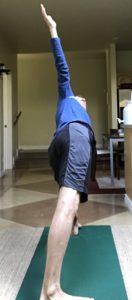
Aligning the Hip for Success in Trikonasana
in Movement Article, Yoga
As the variety and number of classical yoga postures that I continue to teach and practice has decreased, my interest and enthusiasm for certain postures has only increased. Utthita Trikonasana or Extended Triangle Posture is a great example of this. I keep coming back to it and it keeps giving, providing countless opportunities for insight and reflection.
As any student of yoga knows there are as many ways to teach Trikonasana as there are teachers who teach it. This can present a challenge for the student practicing it. What should I focus on? What are the keys to this posture? What should I be doing (or not doing) to prevent injury?
Trikonasa can serve as a litmus test for low back pain and when certain mistakes are made doing it the asana can increase low back issues and even create them when they didn’t exist before. This is espeically a pitfall for yoga teachers and more experienced students who have the strength and stamina to sustain misaligned postures for longer periods. Therefore it is essential that the posture not bring up any existing pain in students who have it and that all students are attentive to executing the posture in a way that doesn’t excessively load the lumbar spine and sacroiliac joints.
I’ve discovered that a single, key early step in this posture will dramatically reduce the tendency to manifest the various problems that this posture can bring up, including low back issues, and it will greatly increase the chances of success in the posture. Basically, this step involves getting the lateral hip aligned vertically with the outer ankle bone.
Notice in the photo to the left (Figure 1) how the my left hip joint (both hips really) is pushed forward of my ankle. This results in a laxity of the muscles in the lateral hip, leaving the muscular support of this hip much to the quadriceps and the forefoot and results in excessive load on the hip and knee joints and a significant misalignment of my spine.
Often accompanying the hip forward is the lower ribcage which tends to shear forward of the lumbar spine (Figure 2). When the ribs shear forward this way, any turn of the rib cage and chest must come primarily from the lumbar spine and will tend to accelerate the hips even more forward, excessively loading the lower back and increasing the load on the hip even further.
Look at how my rib cage in the photo below (Figure 3) reveals the excessive arch in my low back. As I twist to the left, the arching of the back will only increase along with the load on the spine.
Bringing my hip back in line with my ankle bone, or at least closer to it, will go a long way toward resolving these issues.
First, it immediately reduces load on the quadriceps and the anterior hip, reducing stress on the hip and knee joints.
Second, it allows me to relax the gluteus maximus of my front leg hip, making it easier to upright the pelvis and give greater space to the lower lumbar vertebra and sacroiliac joints.
Third, with the added length in the lower back it’s now possible for me to release the rib cage back into a more optimal alignment with the pelvis, further reducing stress on the back. You can see these changes on my Trikonasana in the photo below (Figure 4).
With the hip back in alignment I can initiate the twisting action in the posture from the pelvis, incorporate more abduction in my front hip and reduce the demand on my spine for providing the bulk of the rotation. This alignment will also help to involve my front leg more in the twist for better distribution of loads between the two legs.
Along with optimizing the alignment of the ribcage with the pelvis I have reduced a lot of the load to my lower back and SI joints in this posture and redistributed it into my pelvic floor and legs. Now with the spine communicating directly with my legs I can generate more length through the whole spine and up into the chest and arms and really bring the pose to life!
Overall, bringing my hip back distributes more of the loads in this posture into more places. This improved load distribution serves to strengthen and increase blood and lymph flow to tissues throughout the body and contrasts starkly with a posture that simply overloads the hips, knees and lower back. That’s the difference between a posture that brings health to the body and one that only serves to wear it down.
Recent Blog Posts
Newsletter
Contact Us
Alignment Lab
14 Dutton Court
Sausalito, CA 94965
415-599-5986 (Robert)
415-465-0131 (Tiffany)

